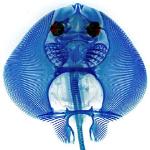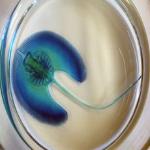14 December 2009

Randall Dahn, MDIBL
Skates are among a unique set of primitive vertebrates that can re-grow their finsRandy Dahn is a research scientist at the Mount Desert Island Biological Laboratory, a non-profit biomedical research facility near Bar Harbor, Maine.
Dahn and his colleagues are studying primitive vertebrates such as skates, which are closely related to sharks and sting rays, to see how they re-grow their fins. They do this by amputating the animals' fins and then studying the genetics of how they regenerate them.
Dahn and his colleagues are studying primitive vertebrates such as skates, which are closely related to sharks and sting rays, to see how they re-grow their fins. They do this by amputating the animals' fins and then studying the genetics of how they regenerate them.

Randall Dahn, MDIBL
Scientists like Dr. Randy Dahn are studying the genes that help vertebrates, like this skate, re-grow their limbs to see if it could work in humansDahn says once they compare and contrast how all these different groups accomplish this feat, they can apply that knowledge to higher vertebrates like humans.
The research builds on decades of study of how animals like salamanders re-grow their limbs. Dahn says scientists already understand how the animals' tissues interact with each another during this process, but they still need to know what's happening at the molecular level.
"So right now we're trying to figure out what genes drive this process," he says. "Once we understand that, we can understand why humans fail to regenerate their limbs and then hopefully - through genetic trickery - restore that ability."
A growing interest in regenerative medicine

Randall Dahn, MDIBL
"We can transplant or substitute for bone pretty well and for skin, and cornea, but not so well for cartilage at all," Dr. Roy Aaron, orthopedic surgeonRegenerative medicine was the topic of a recent symposium at Walter Reed Army Medical Center in Washington, D.C.
One of the guest speakers at the event was Dr. Roy Aaron, an orthopedic surgeon and director of the Center for Restorative and Regenerative Medicine at Brown University in Providence, Rhode Island.
Photo #3, Dr. Roy Aaron
Dr. Aaron says that while amphibians, such as the Mexican salamander, can regenerate an entire limb, no mammals are currently capable of doing that.
"Mammals form a little mass called the blastima," he says, "and then it scars, and quiets down, and doesn't grow."
Limbs are more complicated than organs
Aaron points out that humans do have the ability to re-integrate certain organs, such as the liver and skin, when they have been surgically transplanted into their bodies. But he says accepting grafted tissue is not nearly as complicated a process as re-growing a body part as complex as an entire limb.
"We can actually transplant pancreas, liver, kidney; so those are very promising," he says, "but those are surgical approaches bringing in new tissue as opposed to having an endogenous healing response of a complex tissue like a limb."

Randall Dahn, MDIBL
"I'm confident we're going to be able to do this," Major General George Weightman, associate director, Institute for Regenerative Rehabilitation, Wake Forest University, North CarolinaAnother guest speaker at the Walter Reed symposium was Major General George Weightman, associate director of the Institute for Regenerative Rehabilitation at Wake Forest University's Baptist Medical Center in North Carolina. Weightman shares the view that limb regeneration is an extraordinarily complex process.
Photo #4, George Weightman
"If you think about it, there's bone, there's bone marrow inside the bone, there's cartilage, there's tendon, there's blood vessels there's nerves, there's muscles, there's skin, and how do you get them all not only to grow together and to recognize each other in the same environment, but how to function, quite frankly as a limb?"
Scenarios and options for re-growth
Weightman predicts that as scientists learn more about growing individual tissues their first goal will be to re-grow single fingers before they attempt to re-grow a whole limb.
"Right now I think we're limited to about a centimeter," he says, about the size of a finger tip. But much past a centimeter, he says, things just stop.
Weightman believes that even if we do figure out how to keep the process going, the next question will be whether the regeneration is carried out in the lab or on the amputee's limb.
"One strategy will be to grow a limb, and then put it in a bioreactor [which is a fermentation vat for the production of living organisms] and then transplant it on a person," he says. Another strategy would be, "to put a magic goop [solution] on the end of an amputee that recognizes where it is and what the needs are to generate that limb," he explains.
Regeneration breakthrough may take generations
And when do our experts predict human limb regeneration will become possible? Research scientist Randy Dahn is optimistic.
"I think a reasonable goal is to understand some of the underlying molecular basis in the next five-to-ten years and I think it'll be a fairly rapid transition then to testing these ideas in mice and chickens, which are closely related to humans," he says.
Once that stage is passed, says Dahn, they can test whether or not their therapies are effective in humans.
While he couldn't commit to a specific number, Dahn says limb regeneration in humans can be attainable, "well within our lifetimes."
But Brown University's Roy Aaron believes it's going to take several lifetimes before limb regeneration becomes a medical reality. He says technological advances and improved surgical efforts are currently the main focus of regenerative medicine.
"Some of the new work in prosthetics; micro-processor controlled with linkages to the nervous system," he says, are, "way ahead of the biological opportunities of regeneration."
Weightman agrees that better prosthetics are amputees' best hope in the short term. But he also believes scientists will someday achieve human limb regeneration.
"I'm confident that we'll be able to figure that out, eventually. But it may be a generation, it may be 30 years. I'm not sure which strategy is going to pan out in the long term but I'm confident we're going to be able to do this," he says.